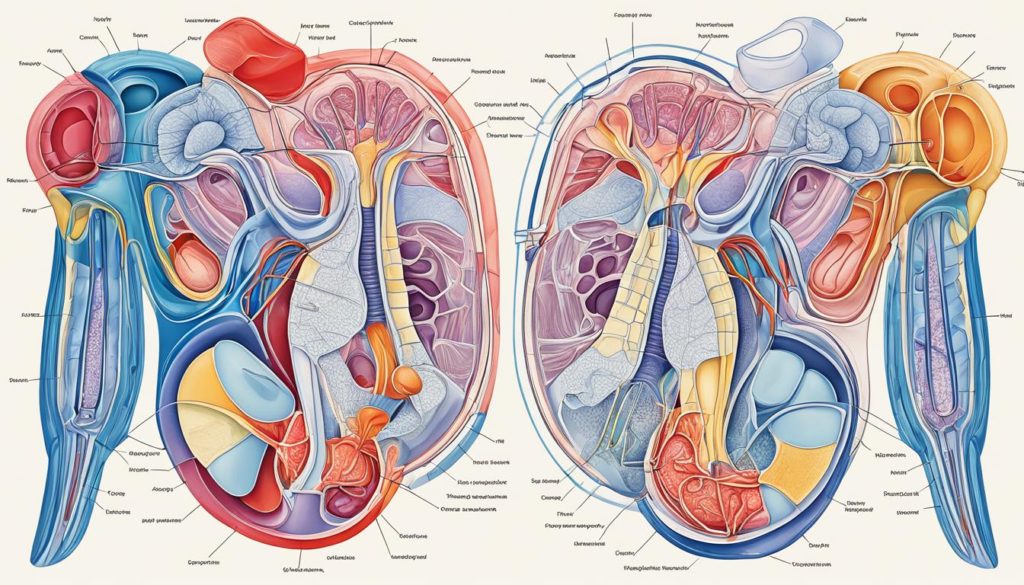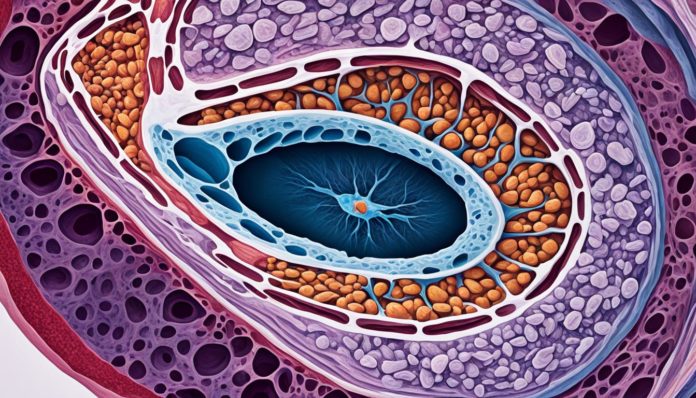Did you know prostate cancer is not just for older men? It’s becoming more common in young adults too. This rise in early-onset prostate cancer is due to better screening and more awareness. Young men with this disease often face aggressive types and have lower survival rates than older men.
Even teenagers and young adults can get prostate cancer, making it a big health concern. The reasons for this increase include genetics, lifestyle, and the environment. It’s important to find and treat it early to help young men with prostate cancer.
Key Takeaways
- Early-onset prostate cancer is on the rise among young men.
- Heightened screening and prostate cancer awareness contribute to increased diagnoses.
- Young men with prostate cancer often face more aggressive disease.
- Genetics, obesity, and environmental factors play significant roles.
- Effective detection and treatment strategies are crucial for young adult cancer patients.
Introduction to Prostate Cancer in Young Men
Prostate cancer is often linked with older men, but it’s key to understand it in younger people too. About 10% of new cases are in young men, showing it’s a significant issue.
Young men with prostate cancer see big health and life quality impacts. Catching it early and using new treatments is crucial. Teaching young men about prostate cancer can lower risks.
Doctors in urologic oncology highlight the need for regular checks and research. These efforts help improve survival chances and quality of life for young men with prostate cancer.

What is the Prostate and How Does it Function?
The prostate is a key part of the male body, vital for fertility and keeping the urinary system healthy. It sits below the bladder and wraps around the urethra. It makes a big part of the semen fluid. Knowing how the prostate works helps us understand its role in men’s health.

The Role of the Prostate in Reproductive Health
The prostate also plays a big part in making sperm healthy and able to move. It adds a fluid to the semen that has important stuff like zinc and enzymes. These help the sperm move well and stay alive. This helps men have healthy sperm for reproduction.
The Anatomy of the Prostate
The prostate is shaped like a walnut and is about the size of one. It has different zones, each doing its own job. The central and peripheral zones are where problems like prostate cancer can start. The prostate’s tissues help it work in both the reproductive and urinary systems.
Common Issues Related to the Prostate
Prostate problems can include BPH, prostatitis, and prostate cancer. BPH makes the prostate bigger and can block the flow of urine. Prostatitis is when the prostate gets inflamed, often from an infection. Prostate cancer can cause trouble peeing, blood in the urine, or pain in the pelvis. Catching these problems early and treating them is key to managing them.
| Prostate Condition | Description | Symptoms |
|---|---|---|
| Benign Prostatic Hyperplasia | Non-cancerous enlargement of the prostate | Frequent urination, weak urine stream |
| Prostatitis | Inflammation of the prostate, often due to infection | Painful urination, pelvic pain |
| Prostate Cancer | Malignant tumor formation within the prostate | Difficulty urinating, blood in urine |
Prostate Cancer Young Men: Prevalence and Statistics
Prostate cancer is more common with age, but it’s also affecting young men more often. This trend shows a worrying increase in cases among the younger population. It’s important to understand these statistics to grasp the growing issue.
Young men are not immune to prostate cancer. In fact, there’s a rise in early cases among this group. This calls for more research to tackle the unique challenges they face.
Survival rates for prostate cancer in young men are lower than in older patients. This fact highlights the need for special studies and support for young patients. It’s crucial to address this issue with targeted efforts.
| Age Group | Incidence Rate | Survival Rate |
|---|---|---|
| Under 40 | Low but Increasing | 75% |
| 40-50 | Moderate | 80% |
| 50-60 | High | 90% |
These statistics show the need for more research on cancer in young men. By studying these trends, doctors aim to improve diagnosis and treatment for young patients. It’s vital to take proactive steps and support research to meet the changing needs of prostate cancer in young people.
Risk Factors for Early Onset Prostate Cancer
Early prostate cancer is affected by many prostate cancer risk factors. This part looks at genetics, lifestyle, and racial differences that increase the chance of getting it young.
Genetics and Family History
A big role of genetic predisposition is seen in early prostate cancer. Men with family history—like a dad or brother with prostate cancer—are more likely to get it too. Knowing your family history helps in preventing cancer.
Lifestyle and Environmental Factors
Our choices and the environment also affect prostate cancer risk factors. Things like diet, exercise, smoking, and toxins matter. Making healthy choices can lower these risks.
Racial and Ethnic Disparities
Racial and ethnic differences are key in early prostate cancer. Black men, for example, get it more often and die from it more. This shows how genetics and environment work together. Fixing these gaps is important for preventing prostate cancer.
Symptoms of Prostate Cancer in Young Men
It can be hard to spot prostate cancer early, as it often doesn’t show symptoms. But as it gets worse, some signs become clear. Key symptoms include a weak stream, needing to pee a lot, especially at night, and trouble starting or stopping.
Look out for hematuria, or blood in your pee, which means your prostate health is not good. Bone pain in places like the hips, back, or thighs can also mean the cancer has spread to your bones.
Unexplained weight loss is another warning sign. It happens when your body can’t handle the cancer. If you notice any of these cancer symptoms, see a doctor right away. Early treatment can make a big difference in how well you do and your prostate health.
Diagnostic Methods for Prostate Cancer
Diagnosing prostate cancer in young men uses both old and new methods. This ensures a thorough check-up and early catch.
Digital Rectal Exam (DRE)
A Digital Rectal Exam (DRE) is a key way to find prostate cancer. A doctor puts a gloved, greased finger into the rectum to feel the prostate. They look for any unusual lumps or hard spots that could mean cancer.
Prostate-Specific Antigen (PSA) Test
The PSA test checks for prostate-specific antigen in blood. High levels might mean prostate cancer, so more tests are done. It’s important to get regular PSA tests, especially for young men without symptoms.
Advanced Imaging Techniques
Tests like MRI, CT scans, and PET scans are key in finding prostate cancer. They give clear pictures of the prostate and nearby tissues. This helps doctors know exactly where the cancer is and how serious it is. This info is vital for making the best treatment plans.
Treatment Options and Strategies
When dealing with prostate cancer, a detailed plan is key. It helps find the best treatments for each patient. There are many ways to treat it, from surgery to advanced therapies.
Surgical Interventions
Radical prostatectomy is often suggested for younger men with prostate cancer. It means taking out the prostate gland to get rid of cancer cells. New techniques can also help keep the ability to have sex after surgery.
Radiation Therapy
Oncology therapies like radiation therapy are vital for prostate cancer. It uses strong rays to kill cancer cells and shrink tumors. It’s good for those who can’t have surgery or to help stop cancer from coming back.
Hormone Therapy
Hormone therapy, or androgen deprivation therapy (ADT), lowers or blocks testosterone. This hormone helps prostate cancer cells grow. By reducing testosterone, this treatment slows down the cancer, making it a strong choice for advanced stages.
Combination Treatments
Using a team approach, combining treatments like surgery, radiation, and hormone therapy works best. This method is great for treating both early and late stages of prostate cancer. It leads to better results.
| Treatment Type | Details |
|---|---|
| Radical Prostatectomy | Complete removal of the prostate gland; may include nerve-sparing techniques |
| Radiation Therapy | High-energy rays targeting cancer cells; used alone or with other treatments |
| Hormone Therapy | Reduction/blocking of testosterone to slow cancer cell growth |
| Combination Treatments | Integrative approach including multiple treatment modalities |
Side Effects and Impact on Quality of Life
Prostate cancer treatment has side effects that affect young men’s quality of life. These include erectile dysfunction, urinary incontinence, and infertility. These issues hit not just physical health but also mental well-being, changing how we care for patients.
Keeping quality of life high is key. Sperm banking helps men save their fertility before treatments like prostatectomy and radiotherapy. Psychological support and counseling are also vital for dealing with depression and anxiety from prostate cancer side effects.
Patients need specific help for these side effects. Medications and therapies can improve sexual health. Pelvic floor exercises help with urinary incontinence. These steps are part of a bigger plan for overall wellness and happiness.
Studies show it’s crucial to think about side effects when deciding on treatments. The aim is not just to survive but to thrive after treatment. This highlights the need for full patient care. Long-term checks and support are key to handling side effects and keeping life quality high.
Prevention and Early Detection Measures
Taking steps early can greatly lower the chance of getting prostate cancer in young men. Catching prostate cancer early is key to better treatment results. Genetic tests help find those at higher risk, so they can get checked more often.
Screening Recommendations
Screening is key for finding prostate cancer early. The American Cancer Society says men should talk with their doctors about PSA tests. These tests can catch cancer early, when it’s easier to treat.
Lifestyle Modifications
Living a healthy life is vital for preventing cancer. Being active, eating well, and not smoking can lower prostate cancer risk. Stress less and keep a healthy weight also help keep your prostate healthy.
Genetic Counseling and Testing
Men with a family history of prostate cancer should consider genetic tests and counseling. Knowing your genes can help you make better choices for prevention. Genetic counselors offer advice on risks and how to lower them based on your genes.
Living with Prostate Cancer: Support and Resources
Getting diagnosed with prostate cancer at a young age brings its own set of challenges. Having the right prostate cancer resources is key to getting through this tough time. Young patients find strength in cancer support groups that offer emotional support, advice, and a sense of community. These groups are crucial for the journey to survivorship.
Being part of a group of survivors can really lift your spirits. Talking in cancer support groups lets people share their stories and tips for coping. It also helps with emotional health. Plus, having access to prostate cancer resources helps patients make smart choices about their health and treatment.
Survivorship is a big part of the care process. It’s not just about managing health after treatment; it’s also about living well. Important prostate cancer resources can help with making lifestyle changes, getting nutrition advice, and starting physical therapy. These tools can really improve your life quality.
| Resource Type | Benefit |
|---|---|
| Cancer Support Groups | Provide emotional support and a platform to share experiences |
| Survivorship Programs | Focus on health management and quality of life post-treatment |
| Educational Resources | Offer information on treatment options and lifestyle advice |
Working together, healthcare providers and patients can create a caring environment. By working as a team, young men with prostate cancer can get the best care and use valuable prostate cancer resources. This teamwork helps build a strong path to survivorship.
Conclusion
Prostate cancer in young men is a serious issue that needs more attention. It’s not as common as in older men, but it’s still important. We need to spread the word more about it to help younger people.
Using studies and data from places like the journal articles and SEER data can help us find better ways to treat it. Early detection and new treatments can make a big difference.
Supporting patients and their families is key. Giving them the right healthcare resources and care can really improve their lives. It shows we care about their well-being.
We must understand the special challenges young men with prostate cancer face. By pushing for more research and education, we can make things better. Let’s work together to help those affected and make sure they get the best care possible.
FAQ
What is early-onset prostate cancer?
Early-onset prostate cancer is when prostate cancer happens to men under 55. It can even start in teens and young adults, but it’s rare. This type of cancer is not as common as in older men.
What are the risk factors for developing prostate cancer at a young age?
Risk factors include family history, diet, exercise, and environmental toxins. Black men get prostate cancer more often, likely because of genetics and their environment.
What symptoms should young men look out for regarding prostate cancer?
Look out for urinary issues, blood in urine, bone pain, and unexplained weight loss. But, early stages might not show symptoms. Regular check-ups are key for catching it early.
How is prostate cancer diagnosed in young men?
Doctors use a digital rectal exam (DRE) and PSA screening to diagnose it. They also use CT, MRI, and PET scans for a full check-up.
What are the common treatment options for prostate cancer in young men?
Treatments include surgery, radiation, hormone therapy, and combinations for different stages of cancer. Each treatment is tailored to the patient.
What are the side effects of prostate cancer treatments?
Side effects can include erectile dysfunction, urinary incontinence, and infertility. These can greatly affect quality of life. Supportive care helps manage these effects.
How can young men prevent prostate cancer or detect it early?
Prevention involves regular check-ups, healthy living, and genetic counseling if there’s a family history. Early detection is key for better outcomes.
What support resources are available for young men diagnosed with prostate cancer?
There are support groups, resources for young patients, and survivorship programs. These offer emotional and practical help. Connecting with other survivors is very helpful.
Why is there an increased focus on prostate cancer in young men?
More young men are getting prostate cancer, often with aggressive types that are harder to treat. This calls for more research and better treatments for this growing issue.


